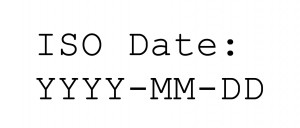You’re familiar with the ISO 8601 standard, right? The one that standardizes date and time formatting internationally? Of course you’re not! That’s why I’m here to explain what the heck it is, and why you should be using it.
Firstly, ISO is the abbreviation for International Organization for Standardization. I know, it should be IOS, but do we really need to be competing with Cisco and Apple for yet another IOS acronym…I digress. The ISO group sets all kinds of standards for various things and their standards are recognized internationally, so it’s always a safe bet to follow them.

ISO 8601 is the particular standard the defines how we represent date and time data. Pop quiz! When you’re entering something in your checkbook register (do people still write checks?), how do you write the date? Month/Day, Month/Day/Year, something else? There is a whole realm of possible ways to write a date, thus the need for a standard.
ISO 8601 states that dates should be expressed in the format of “YYYY-MM-DD”. This means that you will always use a four-digit year, a two-digit month, and a two-digit day. You will never drop the leading zeros. So, for instance, today is February 28, 2016. In the ISO format it would be “2016-02-28”. Makes perfect sense, right?
So why should you be using this format? One of the main advantages of using the ISO date format is when naming and saving digital files. Computer file systems have a unique way of sorting files. If your files are all prefixed with an ISO date, they will automatically sort oldest to newest under the default alphabetical sort, which can be really convenient. Any other date-based naming convention would yield different results.
I have been using the ISO date format for naming any file that has a date associated with it. Bank statements, digital photos, home videos, letters, backups, you name it. Just about every digital file can benefit from being prefixed with an ISO date. I’m also a big advocate of substituting underscores where you would normally use spaces in a file name. This makes it much easier once you enter the web world, where spaces are substituted with the nasty “%20” character string.
Feel free to go back through your entire digital archives and begin adopting this standard. Don’t worry; most of my digital photos are still named DSC00001.jpg, but at least my folder structure honors the standard!
Could not agree more with following this standard! Good summation and examples, Wade. Keep up the good work!
Thanks, Travis! Now if we can only get others to see our way of thinking…
I like it. I am ready for the change.
Since the International Organization for Standards pre-existed both Cisco and Apple, it’s not likely that they named it to avoid confusion with their products.
Rather, they used the Greek word “iso” — meaning, approximately, “same”, to describe the goal of all standards — not to suggest that it wasn’t at least partially inspired by the organization’s initials.
By the way, this information came to me by way of a book describing the Open Standards Interconnection specification, whose acronym is the reverse of ISO.
None of the above should be construed as any kind of disagreement with your recommendation, which is a very good one.